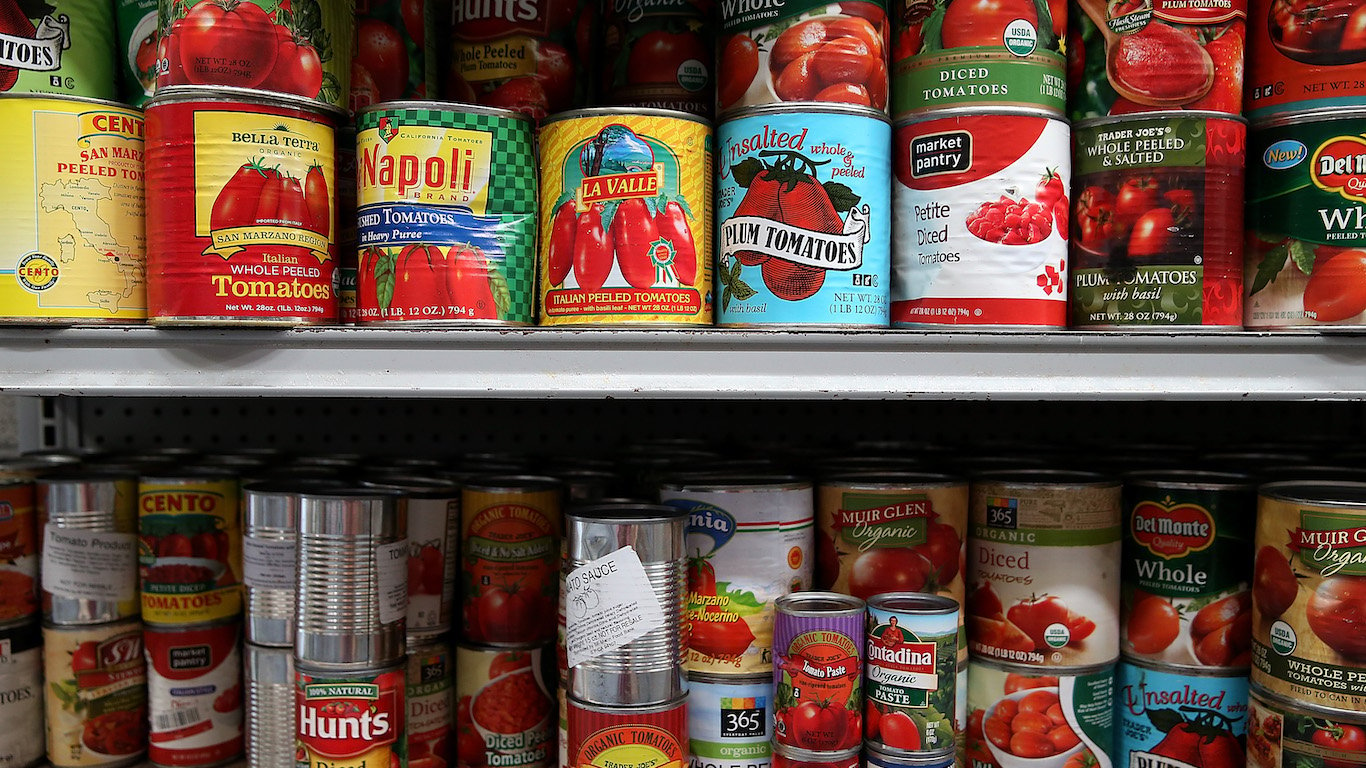

There are more than 40 million Americans living below the poverty line – an income threshold of about $35 per day. Of those facing such extreme financial hardship, children are disproportionately affected, as the United States has one of the worst child poverty rates among wealthy, developed countries. There are nearly 12.6 million Americans under age 18 who live in households with poverty level income.
Not only are children at higher than average risk of poverty, they are also especially vulnerable to poverty’s harmful effects, both in the immediate and long-term.
Childhood poverty can negatively impact brain development and has been linked with a greater likelihood of chronic illness, shorter life expectancy, and poor emotional and behavioral health. Those who spend some or all of their childhood in poverty are also less likely to be successful academically, or, later in life, economically.
Nationwide, an estimated 17.5% of children under age 18 live below the poverty line. This share varies by state, however, and in some parts of the country, child poverty is far more common than average. Using data from the U.S. Census Bureau, 24/7 Wall St. identified the states with the highest child poverty rates.
Among the 50 states, child poverty rates range from 8.9% to over 25%. While states with the lowest child poverty rates span the country, those with the highest child poverty rates are overwhelmingly concentrated in the South. Here is a look at the income a family needs to cover normal living expenses in every state.
Families in states with the highest child poverty rates are far more likely than the average American family to depend on government assistance to afford basic necessities. In each of the 15 states with the highest child poverty rates, the share of households with children receiving SNAP benefits, or food stamps, exceeds the 5.6% national share. Here is a look at the cities with the most people on food stamps.
Click here to see the states where the most children live in poverty
Click here to read our detailed methodology

50. New Hampshire
> Child poverty rate: 8.9%
> Median family income, households with children: $100,798 (4th highest)
> Share of households with children receiving SNAP benefits: 3.1% (3rd lowest)
[in-text-ad]

49. Utah
> Child poverty rate: 9.9%
> Median family income, households with children: $84,298 (14th highest)
> Share of households with children receiving SNAP benefits: 3.8% (8th lowest)

48. North Dakota
> Child poverty rate: 11.1%
> Median family income, households with children: $86,414 (12th highest)
> Share of households with children receiving SNAP benefits: 3.0% (2nd lowest)

47. Colorado
> Child poverty rate: 11.5%
> Median family income, households with children: $91,425 (9th highest)
> Share of households with children receiving SNAP benefits: 3.5% (5th lowest)
[in-text-ad-2]

46. Minnesota
> Child poverty rate: 11.6%
> Median family income, households with children: $95,628 (6th highest)
> Share of households with children receiving SNAP benefits: 3.5% (4th lowest)

45. Maryland
> Child poverty rate: 11.6%
> Median family income, households with children: $103,641 (3rd highest)
> Share of households with children receiving SNAP benefits: 4.9% (21st lowest)
[in-text-ad]

44. Hawaii
> Child poverty rate: 11.7%
> Median family income, households with children: $91,696 (8th highest)
> Share of households with children receiving SNAP benefits: 5.4% (24th lowest)

43. Nebraska
> Child poverty rate: 12.2%
> Median family income, households with children: $77,982 (25th highest)
> Share of households with children receiving SNAP benefits: 4.4% (12th lowest)

42. Massachusetts
> Child poverty rate: 12.2%
> Median family income, households with children: $109,908 (the highest)
> Share of households with children receiving SNAP benefits: 4.5% (14th lowest)
[in-text-ad-2]

41. Wyoming
> Child poverty rate: 12.3%
> Median family income, households with children: $80,825 (21st highest)
> Share of households with children receiving SNAP benefits: 2.7% (the lowest)

40. Vermont
> Child poverty rate: 12.3%
> Median family income, households with children: $81,902 (18th highest)
> Share of households with children receiving SNAP benefits: 3.8% (7th lowest)
[in-text-ad]

39. Washington
> Child poverty rate: 12.6%
> Median family income, households with children: $90,447 (10th highest)
> Share of households with children receiving SNAP benefits: 4.9% (18th lowest)

38. Connecticut
> Child poverty rate: 13.0%
> Median family income, households with children: $100,115 (5th highest)
> Share of households with children receiving SNAP benefits: 4.5% (13th lowest)

37. Virginia
> Child poverty rate: 13.1%
> Median family income, households with children: $93,828 (7th highest)
> Share of households with children receiving SNAP benefits: 4.1% (10th lowest)
[in-text-ad-2]

36. Iowa
> Child poverty rate: 13.3%
> Median family income, households with children: $79,139 (23rd highest)
> Share of households with children receiving SNAP benefits: 4.9% (22nd lowest)

35. New Jersey
> Child poverty rate: 13.3%
> Median family income, households with children: $106,937 (2nd highest)
> Share of households with children receiving SNAP benefits: 4.1% (9th lowest)
[in-text-ad]

34. Alaska
> Child poverty rate: 13.8%
> Median family income, households with children: $88,245 (11th highest)
> Share of households with children receiving SNAP benefits: 5.4% (25th lowest)

33. Kansas
> Child poverty rate: 13.9%
> Median family income, households with children: $74,882 (23rd lowest)
> Share of households with children receiving SNAP benefits: 3.6% (6th lowest)

32. Maine
> Child poverty rate: 14.0%
> Median family income, households with children: $76,852 (25th lowest)
> Share of households with children receiving SNAP benefits: 4.6% (15th lowest)
[in-text-ad-2]

31. Wisconsin
> Child poverty rate: 14.2%
> Median family income, households with children: $81,197 (20th highest)
> Share of households with children receiving SNAP benefits: 4.6% (16th lowest)

30. Idaho
> Child poverty rate: 14.4%
> Median family income, households with children: $69,851 (15th lowest)
> Share of households with children receiving SNAP benefits: 4.9% (19th lowest)
[in-text-ad]

29. Oregon
> Child poverty rate: 15.0%
> Median family income, households with children: $78,939 (24th highest)
> Share of households with children receiving SNAP benefits: 6.1% (11th highest)

28. Montana
> Child poverty rate: 15.2%
> Median family income, households with children: $71,986 (19th lowest)
> Share of households with children receiving SNAP benefits: 4.3% (11th lowest)

27. Rhode Island
> Child poverty rate: 15.6%
> Median family income, households with children: $83,161 (17th highest)
> Share of households with children receiving SNAP benefits: 5.9% (14th highest)
[in-text-ad-2]

26. South Dakota
> Child poverty rate: 16.1%
> Median family income, households with children: $76,789 (24th lowest)
> Share of households with children receiving SNAP benefits: 4.7% (17th lowest)

25. Illinois
> Child poverty rate: 16.2%
> Median family income, households with children: $83,907 (15th highest)
> Share of households with children receiving SNAP benefits: 5.8% (17th highest)
[in-text-ad]

24. Pennsylvania
> Child poverty rate: 16.7%
> Median family income, households with children: $81,257 (19th highest)
> Share of households with children receiving SNAP benefits: 5.7% (21st highest)

23. California
> Child poverty rate: 16.8%
> Median family income, households with children: $84,790 (13th highest)
> Share of households with children receiving SNAP benefits: 5.5% (25th highest)

22. Delaware
> Child poverty rate: 17.2%
> Median family income, households with children: $79,268 (22nd highest)
> Share of households with children receiving SNAP benefits: 5.5% (24th highest)
[in-text-ad-2]

21. Missouri
> Child poverty rate: 17.4%
> Median family income, households with children: $72,033 (20th lowest)
> Share of households with children receiving SNAP benefits: 5.1% (23rd lowest)

20. Indiana
> Child poverty rate: 17.6%
> Median family income, households with children: $70,859 (17th lowest)
> Share of households with children receiving SNAP benefits: 4.9% (20th lowest)
[in-text-ad]

19. Nevada
> Child poverty rate: 17.6%
> Median family income, households with children: $67,738 (12th lowest)
> Share of households with children receiving SNAP benefits: 5.7% (20th highest)

18. Florida
> Child poverty rate: 18.7%
> Median family income, households with children: $65,053 (9th lowest)
> Share of households with children receiving SNAP benefits: 6.1% (12th highest)

17. New York
> Child poverty rate: 18.7%
> Median family income, households with children: $83,272 (16th highest)
> Share of households with children receiving SNAP benefits: 5.6% (22nd highest)
[in-text-ad-2]

16. Michigan
> Child poverty rate: 18.8%
> Median family income, households with children: $73,187 (22nd lowest)
> Share of households with children receiving SNAP benefits: 5.6% (23rd highest)

15. Ohio
> Child poverty rate: 19.1%
> Median family income, households with children: $72,130 (21st lowest)
> Share of households with children receiving SNAP benefits: 5.7% (19th highest)
[in-text-ad]

14. Arizona
> Child poverty rate: 20.0%
> Median family income, households with children: $69,758 (14th lowest)
> Share of households with children receiving SNAP benefits: 5.9% (16th highest)

13. North Carolina
> Child poverty rate: 20.0%
> Median family income, households with children: $68,688 (13th lowest)
> Share of households with children receiving SNAP benefits: 6.1% (13th highest)

12. Texas
> Child poverty rate: 20.0%
> Median family income, households with children: $71,693 (18th lowest)
> Share of households with children receiving SNAP benefits: 7.0% (5th highest)
[in-text-ad-2]

11. Georgia
> Child poverty rate: 20.1%
> Median family income, households with children: $70,326 (16th lowest)
> Share of households with children receiving SNAP benefits: 6.5% (8th highest)

10. Oklahoma
> Child poverty rate: 20.7%
> Median family income, households with children: $62,535 (6th lowest)
> Share of households with children receiving SNAP benefits: 6.6% (7th highest)
[in-text-ad]

9. Tennessee
> Child poverty rate: 20.8%
> Median family income, households with children: $65,852 (11th lowest)
> Share of households with children receiving SNAP benefits: 6.3% (10th highest)

8. South Carolina
> Child poverty rate: 21.2%
> Median family income, households with children: $64,942 (8th lowest)
> Share of households with children receiving SNAP benefits: 5.8% (18th highest)

7. Arkansas
> Child poverty rate: 22.0%
> Median family income, households with children: $59,204 (3rd lowest)
> Share of households with children receiving SNAP benefits: 5.9% (15th highest)
[in-text-ad-2]

6. Kentucky
> Child poverty rate: 22.2%
> Median family income, households with children: $65,096 (10th lowest)
> Share of households with children receiving SNAP benefits: 6.4% (9th highest)

5. Alabama
> Child poverty rate: 22.7%
> Median family income, households with children: $64,790 (7th lowest)
> Share of households with children receiving SNAP benefits: 6.6% (6th highest)
[in-text-ad]

4. West Virginia
> Child poverty rate: 23.1%
> Median family income, households with children: $59,938 (4th lowest)
> Share of households with children receiving SNAP benefits: 7.3% (4th highest)

3. New Mexico
> Child poverty rate: 25.6%
> Median family income, households with children: $54,886 (2nd lowest)
> Share of households with children receiving SNAP benefits: 8.3% (the highest)

2. Louisiana
> Child poverty rate: 26.3%
> Median family income, households with children: $61,722 (5th lowest)
> Share of households with children receiving SNAP benefits: 7.7% (3rd highest)
[in-text-ad-2]

1. Mississippi
> Child poverty rate: 27.6%
> Median family income, households with children: $54,822 (the lowest)
> Share of households with children receiving SNAP benefits: 7.8% (2nd highest)
Methodology
To determine the states where the most children live in poverty, 24/7 Wall St. reviewed five-year estimates of child poverty rates from the U.S. Census Bureau’s 2020 American Community Survey.
States were ranked based on the share of children living in poverty. To break ties, we used the number of children living in poverty.
Additional information on median income for families with children and the share of households with children receiving benefits from the Supplemental Nutrition Assistance Program are also five-year estimates from the 2020 ACS. Because the Census Bureau didn’t release one-year estimates for 2020 due to data collection issues caused by the COVID-19 pandemic, all ACS data are five-year estimates.
Take This Retirement Quiz To Get Matched With A Financial Advisor (Sponsored)
Take the quiz below to get matched with a financial advisor today.
Each advisor has been vetted by SmartAsset and is held to a fiduciary standard to act in your best interests.
Here’s how it works:
1. Answer SmartAsset advisor match quiz
2. Review your pre-screened matches at your leisure. Check out the
advisors’ profiles.
3. Speak with advisors at no cost to you. Have an introductory call on the phone or introduction in person and choose whom to work with in the future
Take the retirement quiz right here.
Thank you for reading! Have some feedback for us?
Contact the 24/7 Wall St. editorial team.
 24/7 Wall St.
24/7 Wall St. 24/7 Wall St.
24/7 Wall St. 24/7 Wall St.
24/7 Wall St.


